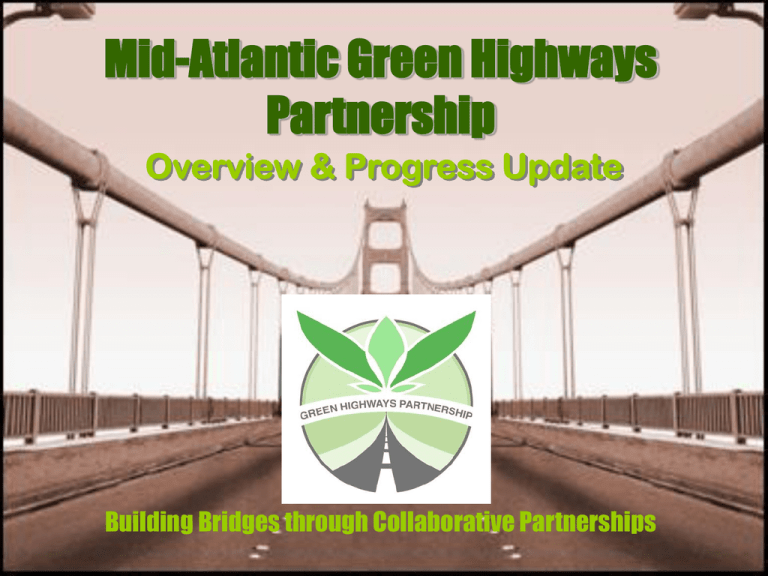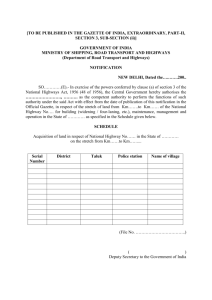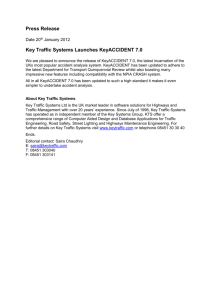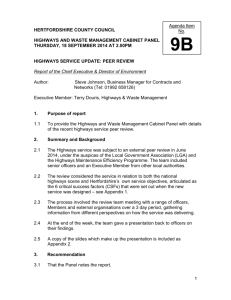Bridge Outline - Maryland Department of the Environment
advertisement

Mid-Atlantic Green Highways Partnership Overview & Progress Update Building Bridges through Collaborative Partnerships How do you define a Green Highway? Cleanse all runoff from highway without adversely affecting adjacent areas sources of hydrology or habitat values Complies with all environmental laws Net increase of chemical, biological, physical functions and values of watershed Reducing the disruption of basic ecological processes Identify, avoid and protect critical resource areas Meet green highways principles Better than before Collaborative Evaluate need and benefit of regulatory flexibility Cost Effectiveness Minimize land clearing within right of way Plant and seed with native vegetation What is the Green Highways Partnership? • Voluntary – Not Regulatory • Collaborative – a “network of industry, trade, & environmental organizations, private sector (consultants & contractors), and government (local, state, & federal). • Public – Private Partnership • Goal is to promote innovation, stewardship, streamlining, and regulatory consistency & flexibility. • To provide greater incentives for streamlining & environmental stewardship in transportation. Why are we doing this? Demand & Expectations from the Public for both agencies Complexity of transportation & environmental problems – environmental & transportation problems not as simple as they used to be. Economic cost of delay – for both building grey infrastructure & solving environmental problems Shrinking Resources … WE need Innovation, Smart Thinking & Good Government to address our common future! Pillars of GHP • Partnerships • Rewards & Recognition • Recognize programs, projects, and activities for excellence in achieving of “better than before” defined for each focus area. • Economic efficiencies and regulatory flexibility • Opportunities – Pilots – Training – Green Highways Partnership Network • Information HUB for all activities related to Green Highways Green Highways Roadmap Major Mile Markers • Establishment of Pilot or Demonstration Projects – to inform & inspire the implementation of practices/actions that are: • Innovative (policy & practice) • Efficient & cost effective ($$$ and time) • Environmentally sound & protective • Establishment of the Green Highways Partnership Network – to promote information exchange & partnership in the Mid-Atlantic • Website & Virtual Private Network • State specific workshops to discuss opportunities & present innovative practices • Build a Business Plan – to develop a self-sustaining Public-Private Partnership What’s happened so far? • Stakeholder meetings - 2004 -2005 (ongoing) • Mid-Atlantic Green Highways Initiative Planning Charrette – June 2005 • Green Highways Ad-Hoc Committee Formed – Definition, Mission Statement, & Objectives created. • Green Highways Forum – November 2005 – Executive Session – Agency and Industry leaders discussed the goals and objectives of GHI and provided input into the future direction of the effort. • Green Highways Partnership Retreat – March 2006 - Development of the Roadmap & formation of Theme Teams • Regulatory Roundtable – October 2006 Theme Teams • Innovative Watershed-Driven Stormwater Management – Promote the integration of public and private stakeholder interest toward the mutual goal of supporting sustainable use of natural resources. • Recycling and Reuse – To promote the environmentally sound and technically acceptable use of industrial materials in the transportation infrastructure • Conservation and Ecosystem Protection – A regional ecosystem framework scaleable to support decision-making, implementation & monitoring that incorporates a set of tailored core data sets/maps & a tailored decision-making process depending on the audience engaged from planning to O&M Green Highways Roadmap Recycle/Reuse Theme Team Plan • Identify state DOT projects to optimize the beneficial use of industrial by-products. – Target 3 states: PA,MD,VA – Work with DOTs & DNR’s/DEQs jointly • Identify Existing Regulations & Specifications – Target states for follow up after information is gathered – Provide technical information to help them overcome hurdles – Exchange best practices • Collection & Dissemination of Information – Develop a toolkit for implementers – House the information/toolkit on GHP website • Contacts & Sources of material Success! • GHP fosters collaboration and leveraging of funding among public and private entities… – GHP leverages several MILLION Dollars for Anacostia River Urban Watershed Partnership – • Focuses on innovative partnerships between transportation organizations & watershed groups to address stormwater & nutrients in the Anacostia Watershed • Funded by $700K EPA Targeted Watershed funding & $300K Department of Transportation – FHWA funds • Matching funds from proposals well over 1 million dollars – American Concrete Pavement Association focusing it’s current research agenda on green practices • pervious concrete & technologies to reduce heat island effects Success! • GHP working with Villanova University and Prince Georges County – to investigate the effectiveness of pervious concrete and porous asphalt – the potential applications of these techniques in roadway construction. • GHP partnering with Maryland State Highway Administration – to develop successful watershed approaches to stormwater management – the application of a Green Infrastructure approach in the project development of Maryland Route 301. – Maryland SHA is striving to make MD 301 a "green highway" through the application of innovative "green" techniques and processes. • GHP influenced Transportation Research Board’s to focus it’s May 2006 Peer Exchange on the Mid-Atlantic Region – Environmental Geospatial Information for Transportation Peer Exchange Contact Information Denise Rigney US EPA Region III 215-814-2726 rigney.denise@epa.gov Dominique Lueckenhoff lueckenhoff.dominique@epa.gov





